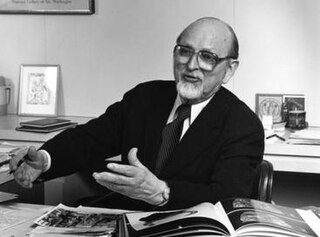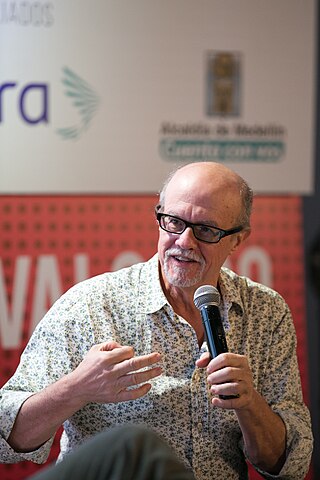Related Research Articles

Aristide Joseph Bonaventure Maillol was a French sculptor, painter, and printmaker.

The Kassel World War II bombings were a set of Allied strategic bombing attacks which took place from February 1942 to March 1945. In a single deadliest raid on 22–23 October 1943, 150,000 inhabitants were bombed-out, at least 6,000 people died, the vast majority of the city center was destroyed, and the fire of the most severe air raid burned for seven days. The US First Army captured Kassel on 3 April 1945, where only 50,000 inhabitants remained, versus 236,000 in 1939.

The Hildebrandslied is a heroic lay written in Old High German alliterative verse. It is the earliest poetic text in German, and it tells of the tragic encounter in battle between a father (Hildebrand) and a son (Hadubrand) who does not recognize him. It is the only surviving example in German of a genre which must have been important in the oral literature of the Germanic tribes.

Nazi plunder was the stealing of art and other items which occurred as a result of the organized looting of European countries during the time of the Nazi Party in Germany. The looting of Jewish property beginning in 1933 in Germany was a key part of the Holocaust. Nazis also plundered occupied countries, sometimes with direct seizures, and sometimes under the guise of protecting art through Kunstschutz units. In addition to gold, silver, and currency, cultural items of great significance were stolen, including paintings, ceramics, books, and religious treasures.

The Universitätsbibliothek Kassel is a library located in the city of Kassel, Germany. Composed of the collections of the former Landesbibliothek and Murhardsche Bibliothek der Stadt Kassel as well as that of the Kassel University library, amongst the library's holdings is the manuscript of the 9th-century German poem, the Hildebrandslied.

Rescuing Da Vinci is a largely photographic, historical book about art reclamation and preservation during and after World War II, written by American author Robert M. Edsel, published in 2006 by Laurel Publishing.

The Monuments, Fine Arts, and Archives program (MFAA) under the Civil Affairs and Military Government Sections of the Allied armies was established in 1943 to help protect cultural property in war areas during and after World War II. The group of approximately 400 service members and civilians worked with military forces to safeguard historic and cultural monuments from war damage, and as the conflict came to a close, to find and return works of art and other items of cultural importance that had been stolen by the Nazis or hidden for safekeeping. Some of them are portrayed and honored in the 2014 film The Monuments Men.

Charles Percy Parkhurst was an American museum curator best known for his work on the Roberts Commission, tracking down art looted during World War II.

Hector Feliciano is a Puerto Rican journalist and author whose book "The Lost Museum: The Nazi Conspiracy to Steal the World's Greatest Works of Art" has shed light on an estimated 20,000 works of art plundered by the Nazis; each one is owned by a museum or a collector somewhere.
Art theft and looting occurred on a massive scale during World War II. It originated with the policies of the Axis countries, primarily Nazi Germany and Japan, which systematically looted occupied territories. Near the end of the war the Soviet Union, in turn, began looting reclaimed and occupied territories. "The grand scale of looted artwork by the Nazis has resulted in the loss of many pieces being scattered across the world."

Seymour Pomrenze was a Jewish-American archivist and records manager. He was the first director of the Offenbach Archival Depot, the primary Allied collection point for books and archival material looted by the Nazis.

Kenyon Vickers Painter was an American banker, noted big game hunter, art collector and philanthropist. In later life, he was convicted of misapplication of funds from his bank, and sentenced to prison.
The Offenbach Archival Depot was a central collecting point in the American Sector of Germany for books, manuscripts and archival materials looted, confiscated or taken by the German army or Nazi government from the occupied countries during World War II. From the Offenbach Archival Depot, these materials of looted art and Nazi plunder were sorted and eventually returned to their original country of origin, or otherwise maintained in new collections.
Leslie Irlyn Poste (1918–1996) was a librarian in the Monuments, Fine Arts, and Archives program at the end of World War II, and was active in the preservation, conservation and restitution of books, scrolls, manuscripts and reports accumulated by the German government from the occupied countries.
Isaac Bencowitz (1896–1972) was a captain in the US Army's Monuments, Fine Arts, and Archives program after World War II.
The German Nazi Party protected art, gold and other objects that had been either plundered or moved for safekeeping at various storage sites during World War II. These sites included salt mines at Altaussee and Merkers and a copper mine at Siegen.

Many priceless artworks by the Dutch post-impressionist artist Vincent van Gogh were looted by Nazis during 1933–1945, mostly from Jewish collectors forced into exile or murdered.
The Hermann Göring Collection, also known as the Kunstsammlung Hermann Göring, was an extensive private art collection of Nazi Reichsmarschall Hermann Göring, formed for the most part by looting of Jewish property in Nazi-occupied areas between 1936 and 1945.
Hermann Voss was a German art historian and museum director appointed by Hitler to acquire art, much of it looted by Nazis, for Hitler's planned Führermuseum in Linz, Austria.
The Marburg Central Collecting Point, also known as the Marburg Central Art Collecting Point, was the first art depot in Post-World War II Germany. It was established by the U.S. Office of Military Government in the university town of Marburg to collect art looted or evacuated from museums, libraries, archives, castles, etc. before and during World War II and return them to their rightful owners. The Collecting Point existed between May 1945 and mid-August 1946.
References
- ↑ The Safekeepers: A Memoir of the Arts at the End of World War II By Walter Ings Farmer, Klaus Goldmann Published by Walter de Gruyter, 2000 ISBN 978-3-11-016897-6, 242 pages
- ↑ "Review of Farmer, Walter I., the Safekeepers: A Memoir of the Arts at the End of World War II and Popa, Opritsa D., Bibliophiles and Bibliothieves: The Search for the Hildebrandslied and the Willehalm Codex". March 2005.
- ↑ "Review of Farmer, Walter I., the Safekeepers: A Memoir of the Arts at the End of World War II and Popa, Opritsa D., Bibliophiles and Bibliothieves: The Search for the Hildebrandslied and the Willehalm Codex". March 2005.
- ↑ Opritsa D. Popa. Bibliophiles and Bibliothieves: The Search for the Hildebrandslied and the Willehalm Codex. Berlin and New York: Walter de Gruyter, 2003. xvi + 265 pp. $58.00 (cloth), ISBN 978-3-11-017730-5
- ↑ Walter I. Farmer. The Safekeepers: A Memoir of the Arts at the End of World War II. Berlin and New York: Walter de Gruyter, 2000. x + 242 pp., ISBN 978-3-11-016897-6